Overview of Project Management Processes and Cultural Impact
VerifiedAdded on 2020/04/01
|8
|1999
|69
Summary
AI Summary
The text outlines the five key phases in a project management life cycle: initiation, planning, execution, monitoring & control, and closure. During these stages, stakeholder management is crucial for successful benefits realization through effective communication strategies like RACI matrices. Project managers must consider cultural dynamics and legal issues to avoid conflicts and resource wastage. Training and skill assessments are vital for team performance. In the project closeout phase, evaluations ensure all objectives have been met before transferring deliverables to stakeholders.
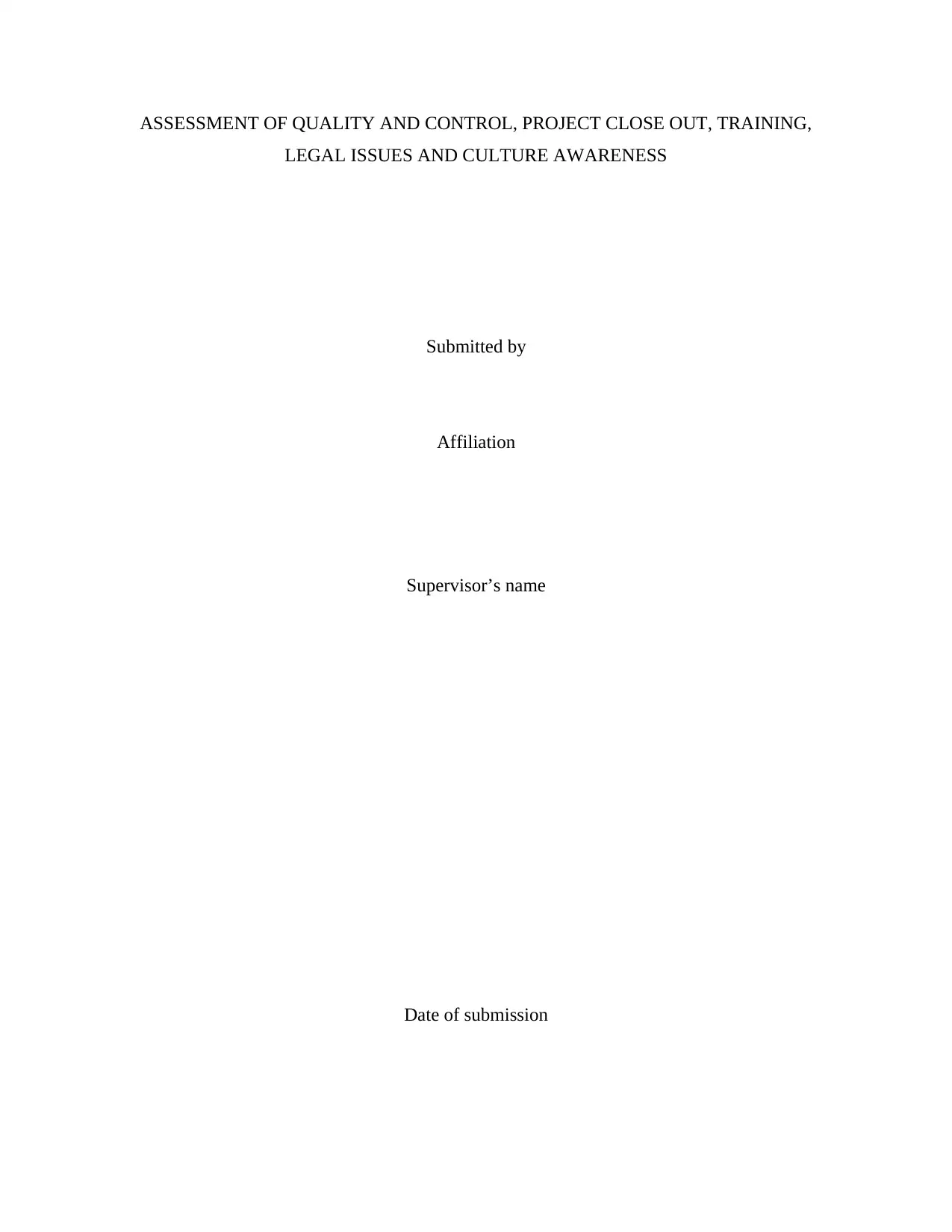
ASSESSMENT OF QUALITY AND CONTROL, PROJECT CLOSE OUT, TRAINING,
LEGAL ISSUES AND CULTURE AWARENESS
Submitted by
Affiliation
Supervisor’s name
Date of submission
LEGAL ISSUES AND CULTURE AWARENESS
Submitted by
Affiliation
Supervisor’s name
Date of submission
Paraphrase This Document
Need a fresh take? Get an instant paraphrase of this document with our AI Paraphraser
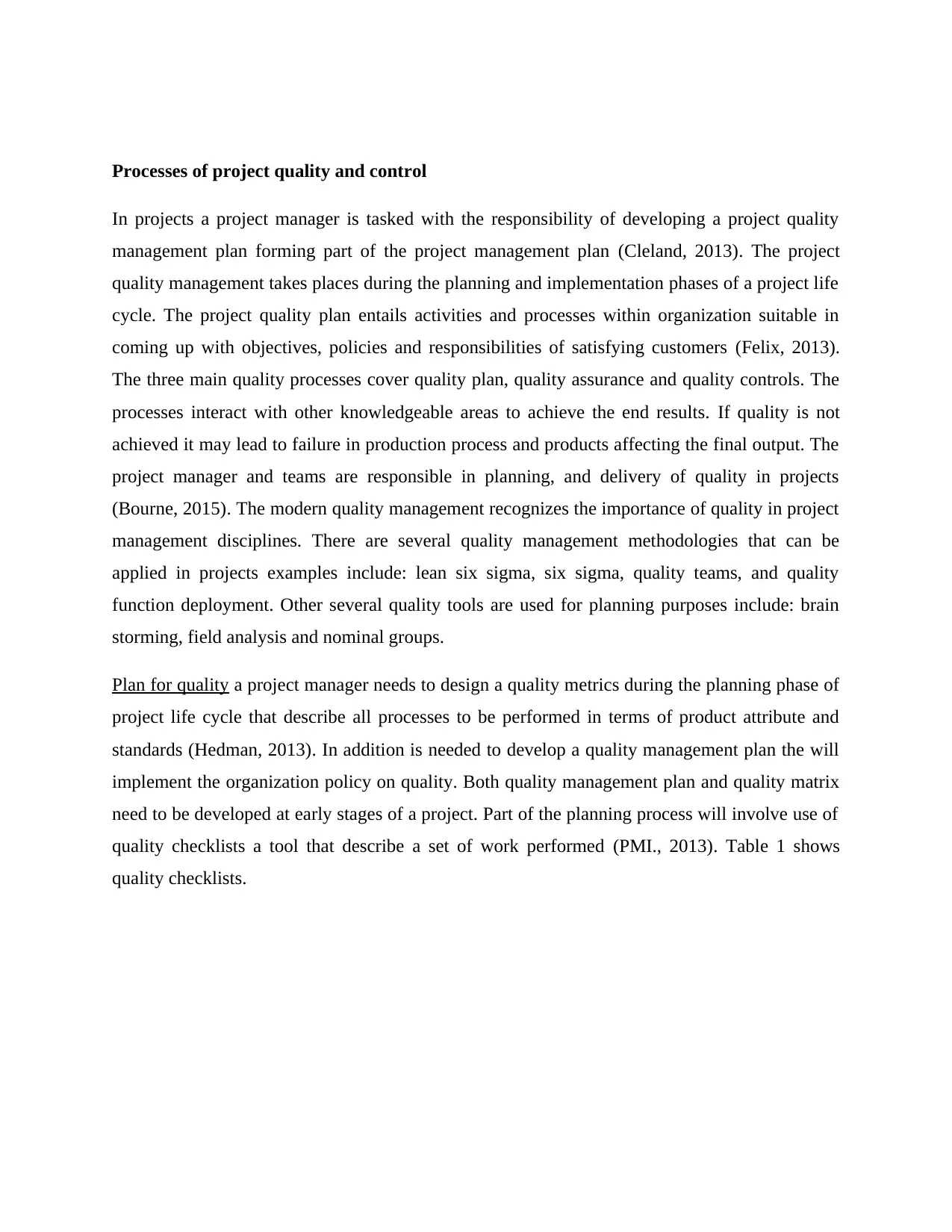
Processes of project quality and control
In projects a project manager is tasked with the responsibility of developing a project quality
management plan forming part of the project management plan (Cleland, 2013). The project
quality management takes places during the planning and implementation phases of a project life
cycle. The project quality plan entails activities and processes within organization suitable in
coming up with objectives, policies and responsibilities of satisfying customers (Felix, 2013).
The three main quality processes cover quality plan, quality assurance and quality controls. The
processes interact with other knowledgeable areas to achieve the end results. If quality is not
achieved it may lead to failure in production process and products affecting the final output. The
project manager and teams are responsible in planning, and delivery of quality in projects
(Bourne, 2015). The modern quality management recognizes the importance of quality in project
management disciplines. There are several quality management methodologies that can be
applied in projects examples include: lean six sigma, six sigma, quality teams, and quality
function deployment. Other several quality tools are used for planning purposes include: brain
storming, field analysis and nominal groups.
Plan for quality a project manager needs to design a quality metrics during the planning phase of
project life cycle that describe all processes to be performed in terms of product attribute and
standards (Hedman, 2013). In addition is needed to develop a quality management plan the will
implement the organization policy on quality. Both quality management plan and quality matrix
need to be developed at early stages of a project. Part of the planning process will involve use of
quality checklists a tool that describe a set of work performed (PMI., 2013). Table 1 shows
quality checklists.
In projects a project manager is tasked with the responsibility of developing a project quality
management plan forming part of the project management plan (Cleland, 2013). The project
quality management takes places during the planning and implementation phases of a project life
cycle. The project quality plan entails activities and processes within organization suitable in
coming up with objectives, policies and responsibilities of satisfying customers (Felix, 2013).
The three main quality processes cover quality plan, quality assurance and quality controls. The
processes interact with other knowledgeable areas to achieve the end results. If quality is not
achieved it may lead to failure in production process and products affecting the final output. The
project manager and teams are responsible in planning, and delivery of quality in projects
(Bourne, 2015). The modern quality management recognizes the importance of quality in project
management disciplines. There are several quality management methodologies that can be
applied in projects examples include: lean six sigma, six sigma, quality teams, and quality
function deployment. Other several quality tools are used for planning purposes include: brain
storming, field analysis and nominal groups.
Plan for quality a project manager needs to design a quality metrics during the planning phase of
project life cycle that describe all processes to be performed in terms of product attribute and
standards (Hedman, 2013). In addition is needed to develop a quality management plan the will
implement the organization policy on quality. Both quality management plan and quality matrix
need to be developed at early stages of a project. Part of the planning process will involve use of
quality checklists a tool that describe a set of work performed (PMI., 2013). Table 1 shows
quality checklists.
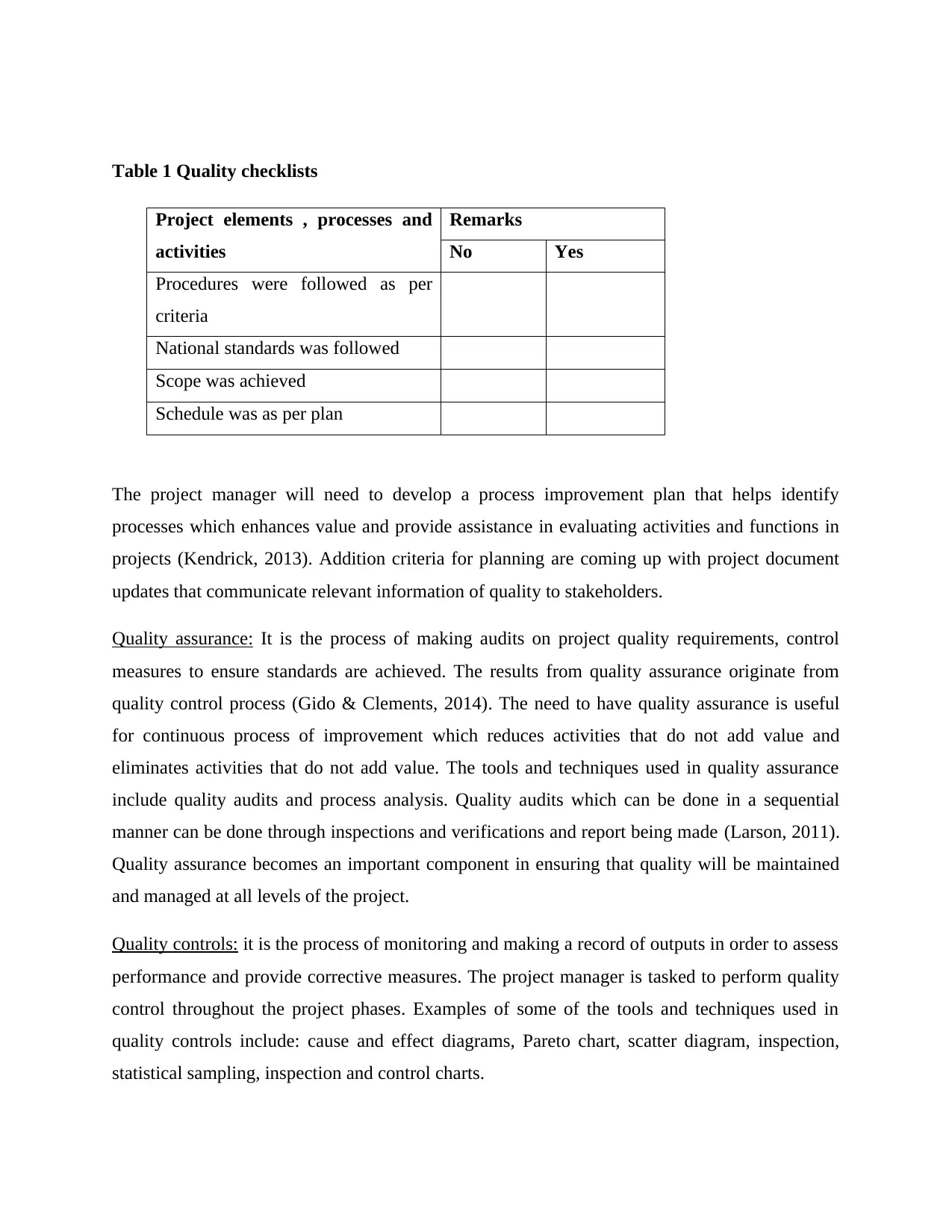
Table 1 Quality checklists
Project elements , processes and
activities
Remarks
No Yes
Procedures were followed as per
criteria
National standards was followed
Scope was achieved
Schedule was as per plan
The project manager will need to develop a process improvement plan that helps identify
processes which enhances value and provide assistance in evaluating activities and functions in
projects (Kendrick, 2013). Addition criteria for planning are coming up with project document
updates that communicate relevant information of quality to stakeholders.
Quality assurance: It is the process of making audits on project quality requirements, control
measures to ensure standards are achieved. The results from quality assurance originate from
quality control process (Gido & Clements, 2014). The need to have quality assurance is useful
for continuous process of improvement which reduces activities that do not add value and
eliminates activities that do not add value. The tools and techniques used in quality assurance
include quality audits and process analysis. Quality audits which can be done in a sequential
manner can be done through inspections and verifications and report being made (Larson, 2011).
Quality assurance becomes an important component in ensuring that quality will be maintained
and managed at all levels of the project.
Quality controls: it is the process of monitoring and making a record of outputs in order to assess
performance and provide corrective measures. The project manager is tasked to perform quality
control throughout the project phases. Examples of some of the tools and techniques used in
quality controls include: cause and effect diagrams, Pareto chart, scatter diagram, inspection,
statistical sampling, inspection and control charts.
Project elements , processes and
activities
Remarks
No Yes
Procedures were followed as per
criteria
National standards was followed
Scope was achieved
Schedule was as per plan
The project manager will need to develop a process improvement plan that helps identify
processes which enhances value and provide assistance in evaluating activities and functions in
projects (Kendrick, 2013). Addition criteria for planning are coming up with project document
updates that communicate relevant information of quality to stakeholders.
Quality assurance: It is the process of making audits on project quality requirements, control
measures to ensure standards are achieved. The results from quality assurance originate from
quality control process (Gido & Clements, 2014). The need to have quality assurance is useful
for continuous process of improvement which reduces activities that do not add value and
eliminates activities that do not add value. The tools and techniques used in quality assurance
include quality audits and process analysis. Quality audits which can be done in a sequential
manner can be done through inspections and verifications and report being made (Larson, 2011).
Quality assurance becomes an important component in ensuring that quality will be maintained
and managed at all levels of the project.
Quality controls: it is the process of monitoring and making a record of outputs in order to assess
performance and provide corrective measures. The project manager is tasked to perform quality
control throughout the project phases. Examples of some of the tools and techniques used in
quality controls include: cause and effect diagrams, Pareto chart, scatter diagram, inspection,
statistical sampling, inspection and control charts.
⊘ This is a preview!⊘
Do you want full access?
Subscribe today to unlock all pages.

Trusted by 1+ million students worldwide
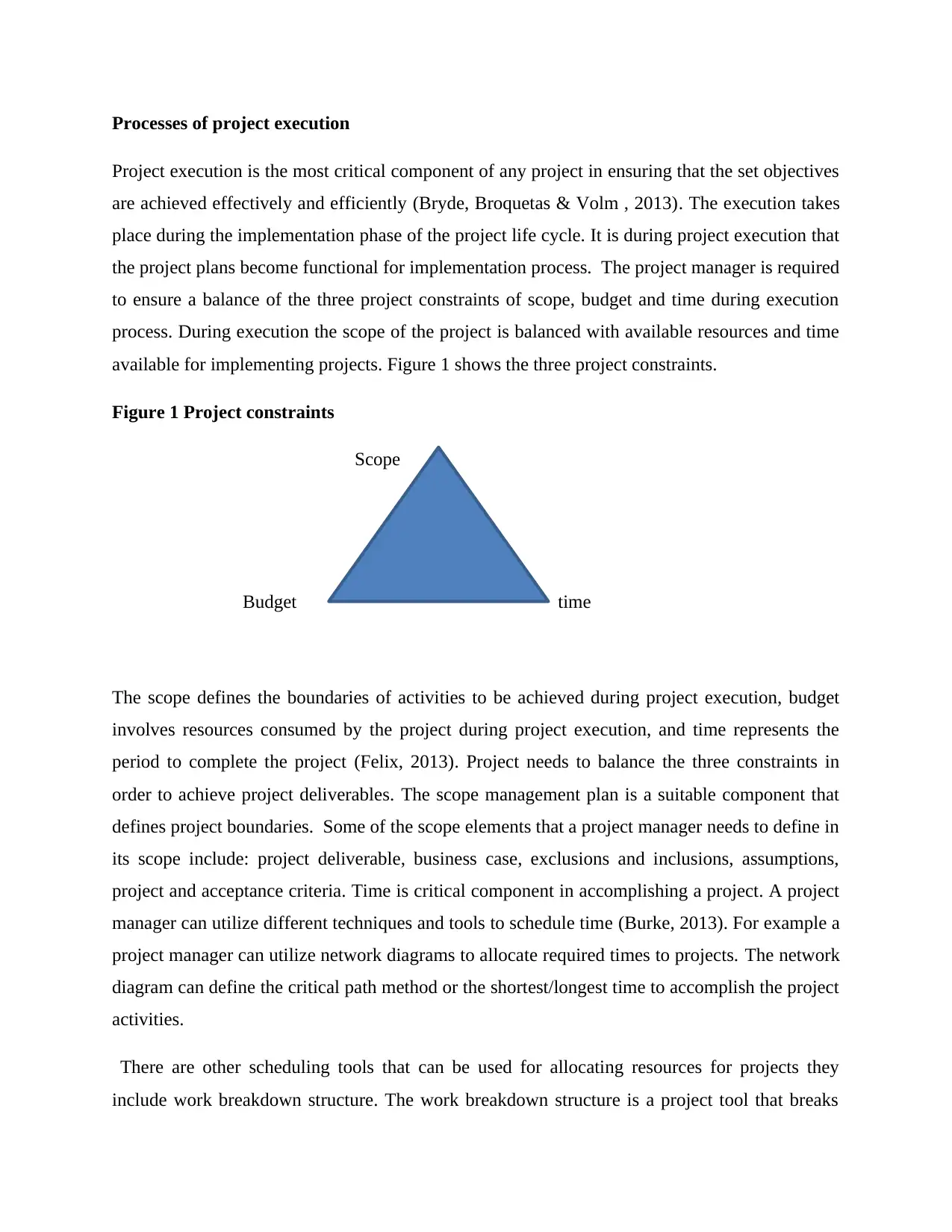
Processes of project execution
Project execution is the most critical component of any project in ensuring that the set objectives
are achieved effectively and efficiently (Bryde, Broquetas & Volm , 2013). The execution takes
place during the implementation phase of the project life cycle. It is during project execution that
the project plans become functional for implementation process. The project manager is required
to ensure a balance of the three project constraints of scope, budget and time during execution
process. During execution the scope of the project is balanced with available resources and time
available for implementing projects. Figure 1 shows the three project constraints.
Figure 1 Project constraints
Scope
Budget time
The scope defines the boundaries of activities to be achieved during project execution, budget
involves resources consumed by the project during project execution, and time represents the
period to complete the project (Felix, 2013). Project needs to balance the three constraints in
order to achieve project deliverables. The scope management plan is a suitable component that
defines project boundaries. Some of the scope elements that a project manager needs to define in
its scope include: project deliverable, business case, exclusions and inclusions, assumptions,
project and acceptance criteria. Time is critical component in accomplishing a project. A project
manager can utilize different techniques and tools to schedule time (Burke, 2013). For example a
project manager can utilize network diagrams to allocate required times to projects. The network
diagram can define the critical path method or the shortest/longest time to accomplish the project
activities.
There are other scheduling tools that can be used for allocating resources for projects they
include work breakdown structure. The work breakdown structure is a project tool that breaks
Project execution is the most critical component of any project in ensuring that the set objectives
are achieved effectively and efficiently (Bryde, Broquetas & Volm , 2013). The execution takes
place during the implementation phase of the project life cycle. It is during project execution that
the project plans become functional for implementation process. The project manager is required
to ensure a balance of the three project constraints of scope, budget and time during execution
process. During execution the scope of the project is balanced with available resources and time
available for implementing projects. Figure 1 shows the three project constraints.
Figure 1 Project constraints
Scope
Budget time
The scope defines the boundaries of activities to be achieved during project execution, budget
involves resources consumed by the project during project execution, and time represents the
period to complete the project (Felix, 2013). Project needs to balance the three constraints in
order to achieve project deliverables. The scope management plan is a suitable component that
defines project boundaries. Some of the scope elements that a project manager needs to define in
its scope include: project deliverable, business case, exclusions and inclusions, assumptions,
project and acceptance criteria. Time is critical component in accomplishing a project. A project
manager can utilize different techniques and tools to schedule time (Burke, 2013). For example a
project manager can utilize network diagrams to allocate required times to projects. The network
diagram can define the critical path method or the shortest/longest time to accomplish the project
activities.
There are other scheduling tools that can be used for allocating resources for projects they
include work breakdown structure. The work breakdown structure is a project tool that breaks
Paraphrase This Document
Need a fresh take? Get an instant paraphrase of this document with our AI Paraphraser
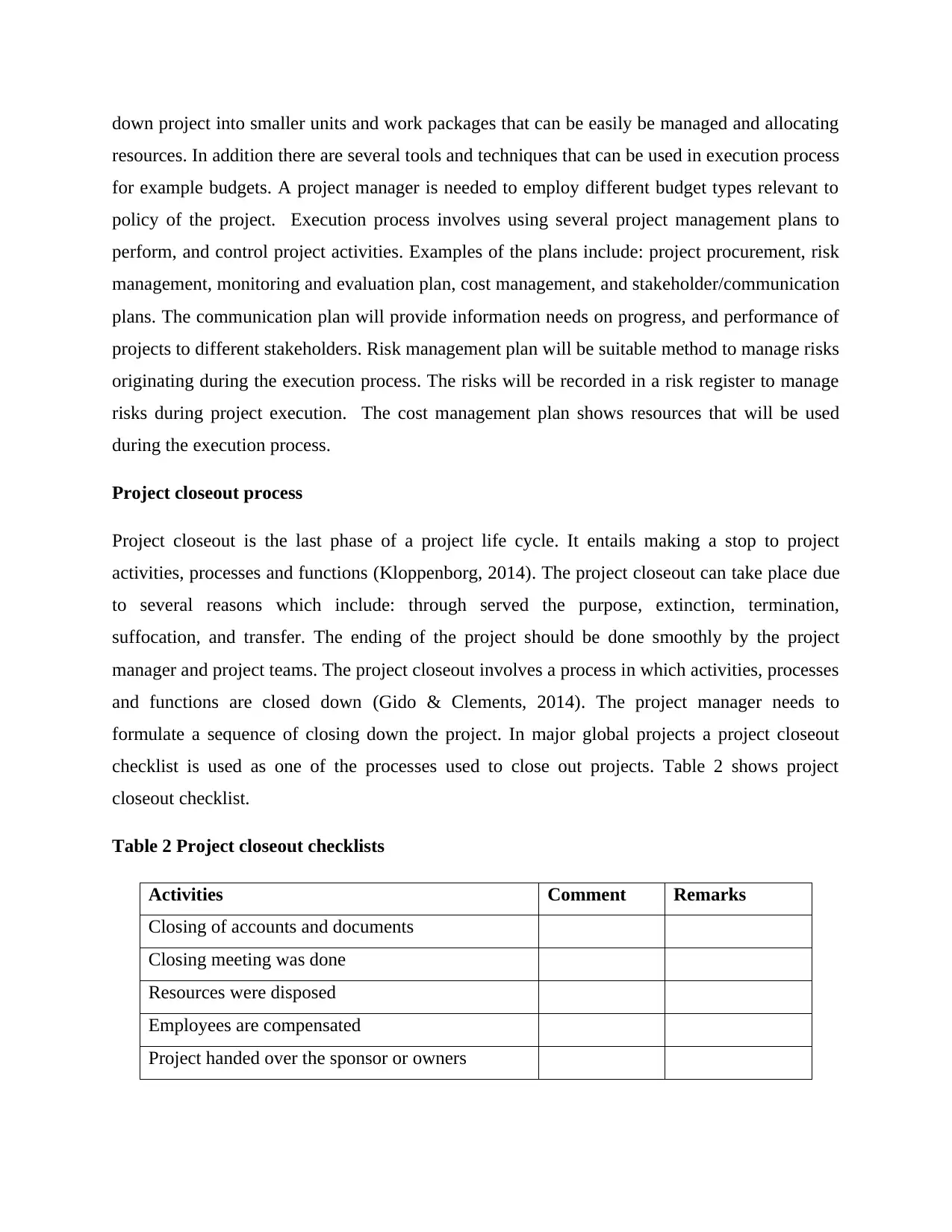
down project into smaller units and work packages that can be easily be managed and allocating
resources. In addition there are several tools and techniques that can be used in execution process
for example budgets. A project manager is needed to employ different budget types relevant to
policy of the project. Execution process involves using several project management plans to
perform, and control project activities. Examples of the plans include: project procurement, risk
management, monitoring and evaluation plan, cost management, and stakeholder/communication
plans. The communication plan will provide information needs on progress, and performance of
projects to different stakeholders. Risk management plan will be suitable method to manage risks
originating during the execution process. The risks will be recorded in a risk register to manage
risks during project execution. The cost management plan shows resources that will be used
during the execution process.
Project closeout process
Project closeout is the last phase of a project life cycle. It entails making a stop to project
activities, processes and functions (Kloppenborg, 2014). The project closeout can take place due
to several reasons which include: through served the purpose, extinction, termination,
suffocation, and transfer. The ending of the project should be done smoothly by the project
manager and project teams. The project closeout involves a process in which activities, processes
and functions are closed down (Gido & Clements, 2014). The project manager needs to
formulate a sequence of closing down the project. In major global projects a project closeout
checklist is used as one of the processes used to close out projects. Table 2 shows project
closeout checklist.
Table 2 Project closeout checklists
Activities Comment Remarks
Closing of accounts and documents
Closing meeting was done
Resources were disposed
Employees are compensated
Project handed over the sponsor or owners
resources. In addition there are several tools and techniques that can be used in execution process
for example budgets. A project manager is needed to employ different budget types relevant to
policy of the project. Execution process involves using several project management plans to
perform, and control project activities. Examples of the plans include: project procurement, risk
management, monitoring and evaluation plan, cost management, and stakeholder/communication
plans. The communication plan will provide information needs on progress, and performance of
projects to different stakeholders. Risk management plan will be suitable method to manage risks
originating during the execution process. The risks will be recorded in a risk register to manage
risks during project execution. The cost management plan shows resources that will be used
during the execution process.
Project closeout process
Project closeout is the last phase of a project life cycle. It entails making a stop to project
activities, processes and functions (Kloppenborg, 2014). The project closeout can take place due
to several reasons which include: through served the purpose, extinction, termination,
suffocation, and transfer. The ending of the project should be done smoothly by the project
manager and project teams. The project closeout involves a process in which activities, processes
and functions are closed down (Gido & Clements, 2014). The project manager needs to
formulate a sequence of closing down the project. In major global projects a project closeout
checklist is used as one of the processes used to close out projects. Table 2 shows project
closeout checklist.
Table 2 Project closeout checklists
Activities Comment Remarks
Closing of accounts and documents
Closing meeting was done
Resources were disposed
Employees are compensated
Project handed over the sponsor or owners
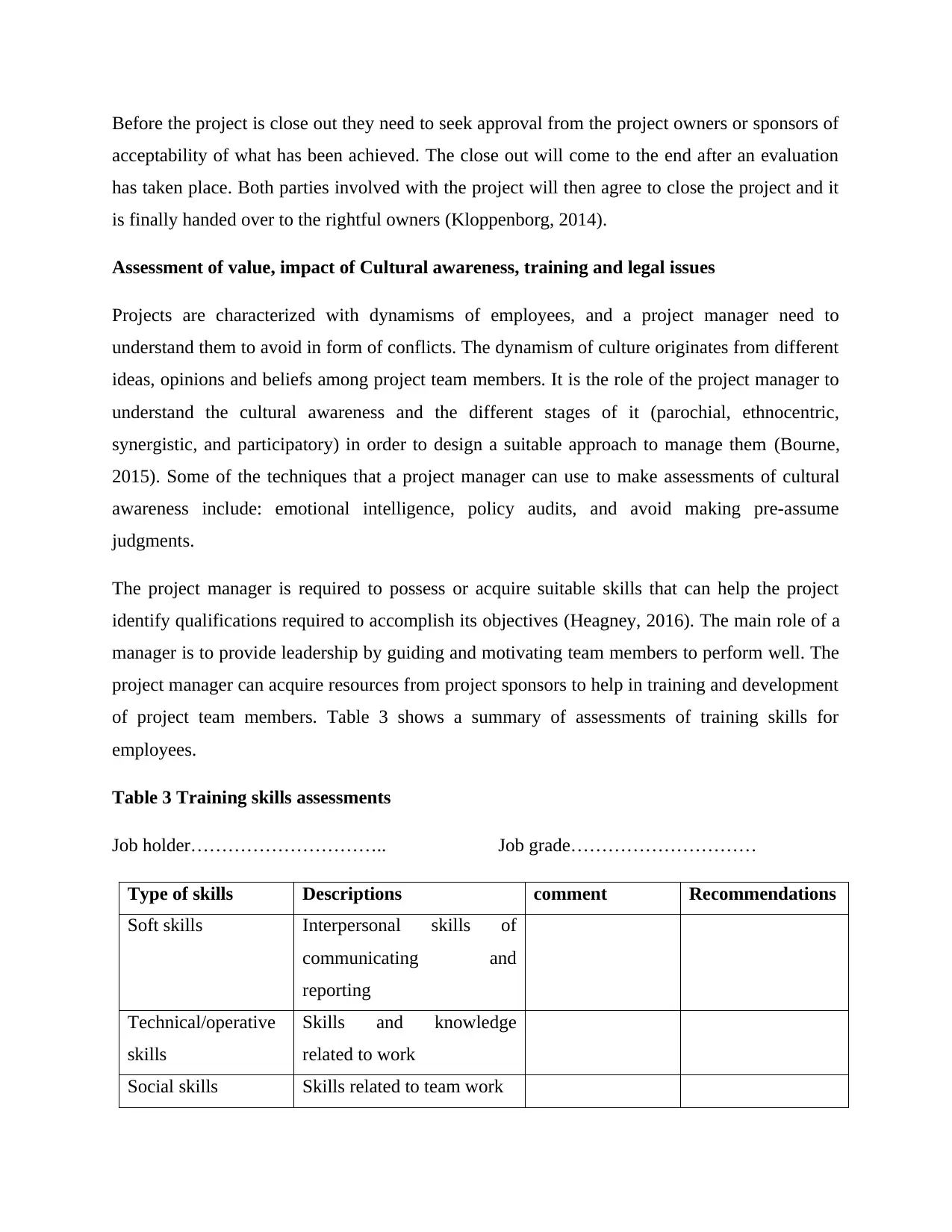
Before the project is close out they need to seek approval from the project owners or sponsors of
acceptability of what has been achieved. The close out will come to the end after an evaluation
has taken place. Both parties involved with the project will then agree to close the project and it
is finally handed over to the rightful owners (Kloppenborg, 2014).
Assessment of value, impact of Cultural awareness, training and legal issues
Projects are characterized with dynamisms of employees, and a project manager need to
understand them to avoid in form of conflicts. The dynamism of culture originates from different
ideas, opinions and beliefs among project team members. It is the role of the project manager to
understand the cultural awareness and the different stages of it (parochial, ethnocentric,
synergistic, and participatory) in order to design a suitable approach to manage them (Bourne,
2015). Some of the techniques that a project manager can use to make assessments of cultural
awareness include: emotional intelligence, policy audits, and avoid making pre-assume
judgments.
The project manager is required to possess or acquire suitable skills that can help the project
identify qualifications required to accomplish its objectives (Heagney, 2016). The main role of a
manager is to provide leadership by guiding and motivating team members to perform well. The
project manager can acquire resources from project sponsors to help in training and development
of project team members. Table 3 shows a summary of assessments of training skills for
employees.
Table 3 Training skills assessments
Job holder………………………….. Job grade…………………………
Type of skills Descriptions comment Recommendations
Soft skills Interpersonal skills of
communicating and
reporting
Technical/operative
skills
Skills and knowledge
related to work
Social skills Skills related to team work
acceptability of what has been achieved. The close out will come to the end after an evaluation
has taken place. Both parties involved with the project will then agree to close the project and it
is finally handed over to the rightful owners (Kloppenborg, 2014).
Assessment of value, impact of Cultural awareness, training and legal issues
Projects are characterized with dynamisms of employees, and a project manager need to
understand them to avoid in form of conflicts. The dynamism of culture originates from different
ideas, opinions and beliefs among project team members. It is the role of the project manager to
understand the cultural awareness and the different stages of it (parochial, ethnocentric,
synergistic, and participatory) in order to design a suitable approach to manage them (Bourne,
2015). Some of the techniques that a project manager can use to make assessments of cultural
awareness include: emotional intelligence, policy audits, and avoid making pre-assume
judgments.
The project manager is required to possess or acquire suitable skills that can help the project
identify qualifications required to accomplish its objectives (Heagney, 2016). The main role of a
manager is to provide leadership by guiding and motivating team members to perform well. The
project manager can acquire resources from project sponsors to help in training and development
of project team members. Table 3 shows a summary of assessments of training skills for
employees.
Table 3 Training skills assessments
Job holder………………………….. Job grade…………………………
Type of skills Descriptions comment Recommendations
Soft skills Interpersonal skills of
communicating and
reporting
Technical/operative
skills
Skills and knowledge
related to work
Social skills Skills related to team work
⊘ This is a preview!⊘
Do you want full access?
Subscribe today to unlock all pages.

Trusted by 1+ million students worldwide
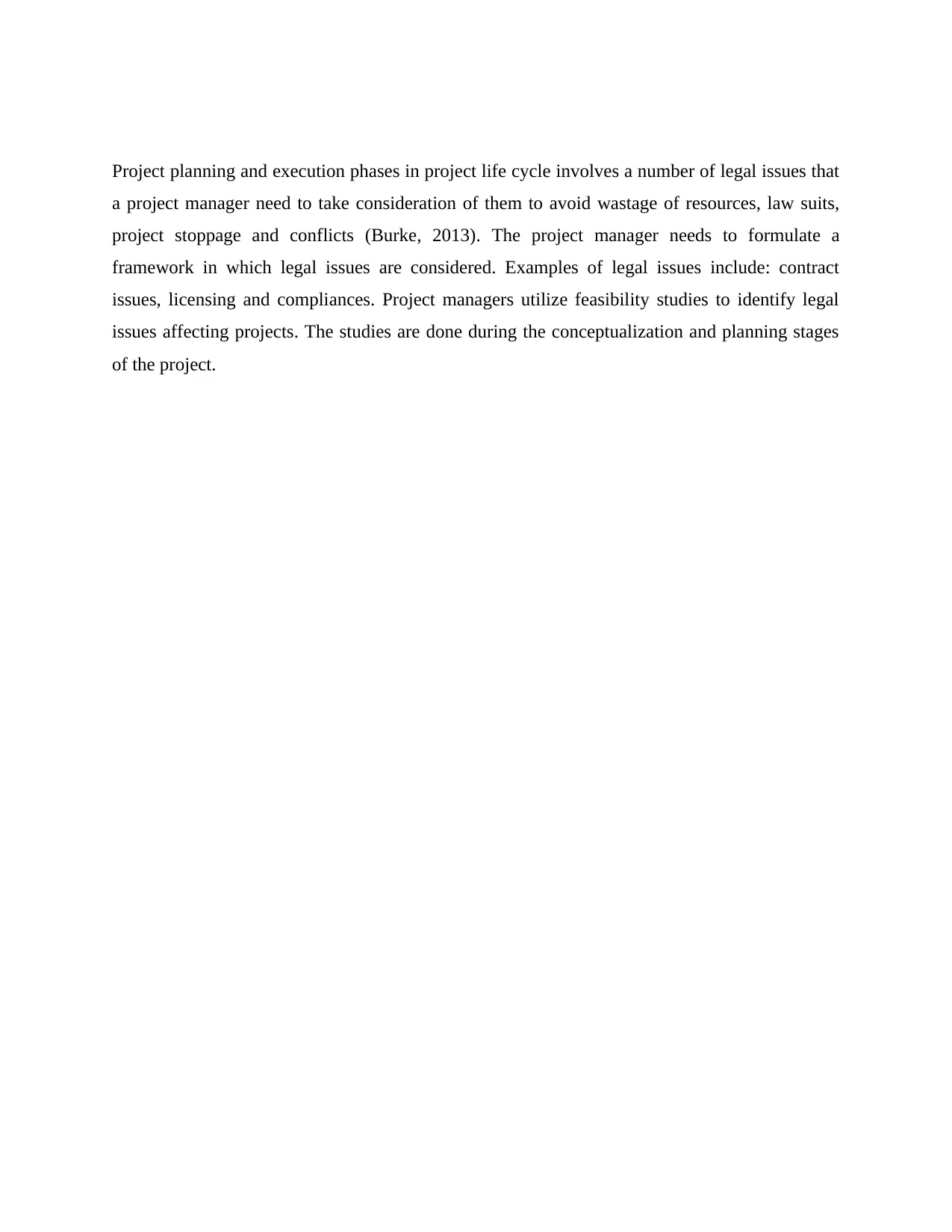
Project planning and execution phases in project life cycle involves a number of legal issues that
a project manager need to take consideration of them to avoid wastage of resources, law suits,
project stoppage and conflicts (Burke, 2013). The project manager needs to formulate a
framework in which legal issues are considered. Examples of legal issues include: contract
issues, licensing and compliances. Project managers utilize feasibility studies to identify legal
issues affecting projects. The studies are done during the conceptualization and planning stages
of the project.
a project manager need to take consideration of them to avoid wastage of resources, law suits,
project stoppage and conflicts (Burke, 2013). The project manager needs to formulate a
framework in which legal issues are considered. Examples of legal issues include: contract
issues, licensing and compliances. Project managers utilize feasibility studies to identify legal
issues affecting projects. The studies are done during the conceptualization and planning stages
of the project.
Paraphrase This Document
Need a fresh take? Get an instant paraphrase of this document with our AI Paraphraser
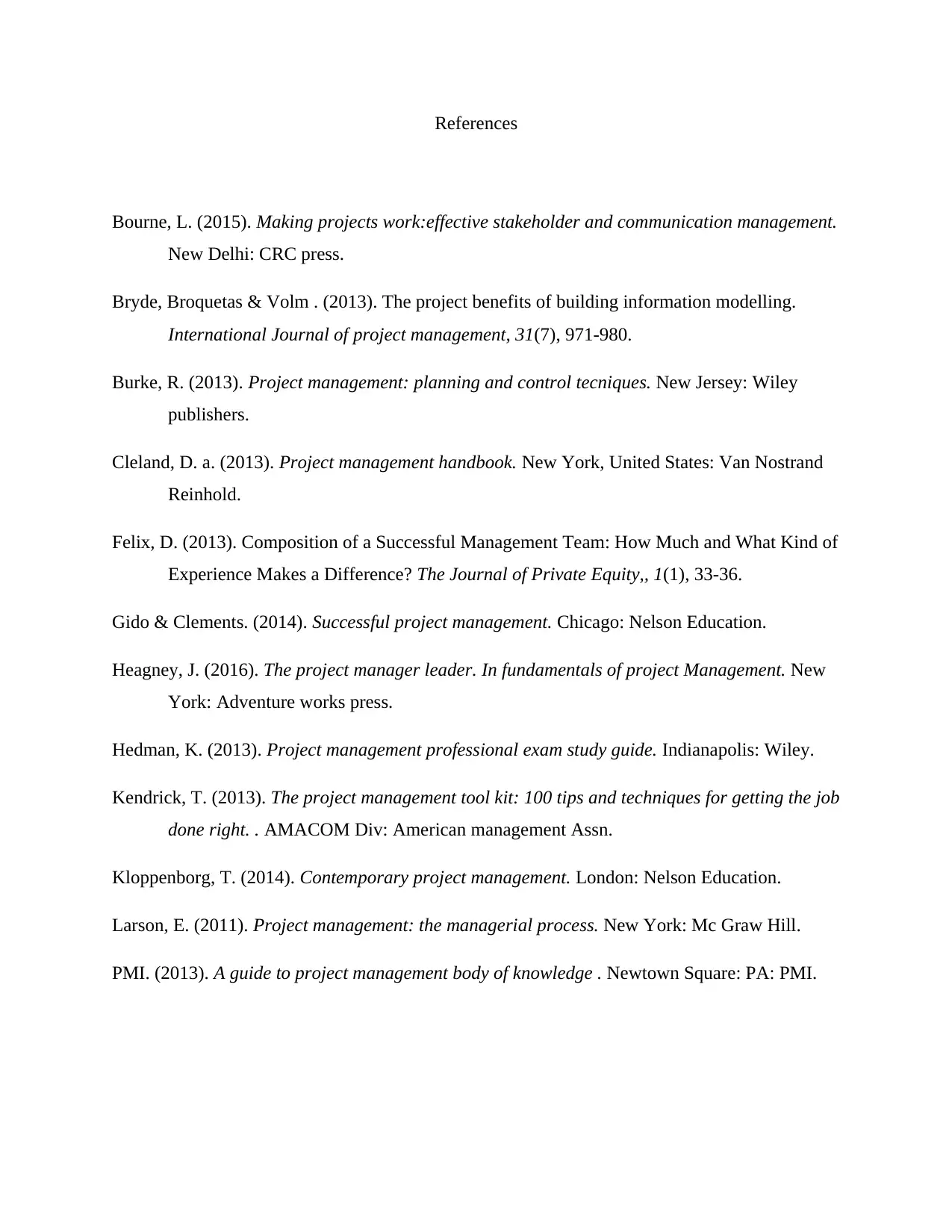
References
Bourne, L. (2015). Making projects work:effective stakeholder and communication management.
New Delhi: CRC press.
Bryde, Broquetas & Volm . (2013). The project benefits of building information modelling.
International Journal of project management, 31(7), 971-980.
Burke, R. (2013). Project management: planning and control tecniques. New Jersey: Wiley
publishers.
Cleland, D. a. (2013). Project management handbook. New York, United States: Van Nostrand
Reinhold.
Felix, D. (2013). Composition of a Successful Management Team: How Much and What Kind of
Experience Makes a Difference? The Journal of Private Equity,, 1(1), 33-36.
Gido & Clements. (2014). Successful project management. Chicago: Nelson Education.
Heagney, J. (2016). The project manager leader. In fundamentals of project Management. New
York: Adventure works press.
Hedman, K. (2013). Project management professional exam study guide. Indianapolis: Wiley.
Kendrick, T. (2013). The project management tool kit: 100 tips and techniques for getting the job
done right. . AMACOM Div: American management Assn.
Kloppenborg, T. (2014). Contemporary project management. London: Nelson Education.
Larson, E. (2011). Project management: the managerial process. New York: Mc Graw Hill.
PMI. (2013). A guide to project management body of knowledge . Newtown Square: PA: PMI.
Bourne, L. (2015). Making projects work:effective stakeholder and communication management.
New Delhi: CRC press.
Bryde, Broquetas & Volm . (2013). The project benefits of building information modelling.
International Journal of project management, 31(7), 971-980.
Burke, R. (2013). Project management: planning and control tecniques. New Jersey: Wiley
publishers.
Cleland, D. a. (2013). Project management handbook. New York, United States: Van Nostrand
Reinhold.
Felix, D. (2013). Composition of a Successful Management Team: How Much and What Kind of
Experience Makes a Difference? The Journal of Private Equity,, 1(1), 33-36.
Gido & Clements. (2014). Successful project management. Chicago: Nelson Education.
Heagney, J. (2016). The project manager leader. In fundamentals of project Management. New
York: Adventure works press.
Hedman, K. (2013). Project management professional exam study guide. Indianapolis: Wiley.
Kendrick, T. (2013). The project management tool kit: 100 tips and techniques for getting the job
done right. . AMACOM Div: American management Assn.
Kloppenborg, T. (2014). Contemporary project management. London: Nelson Education.
Larson, E. (2011). Project management: the managerial process. New York: Mc Graw Hill.
PMI. (2013). A guide to project management body of knowledge . Newtown Square: PA: PMI.
1 out of 8
Related Documents
Your All-in-One AI-Powered Toolkit for Academic Success.
+13062052269
info@desklib.com
Available 24*7 on WhatsApp / Email
![[object Object]](/_next/static/media/star-bottom.7253800d.svg)
Unlock your academic potential
Copyright © 2020–2025 A2Z Services. All Rights Reserved. Developed and managed by ZUCOL.





